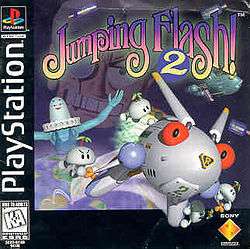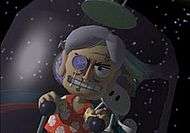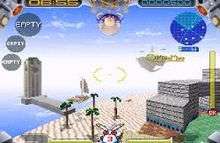Jumping Flash! 2
| Jumping Flash! 2 | |
|---|---|
 Jumping Flash! 2 box art featuring the protagonist Robbit and antagonist Captain Kabuki in the background, to the left | |
| Developer(s) | Exact |
| Publisher(s) | Sony Computer Entertainment |
| Director(s) | Koji Tada |
| Producer(s) |
Tetsuji Yamamoto Junichiro Ueno Yukihito Morikawa |
| Designer(s) |
Toshimitsu Odaira Shuji Nomaguchi |
| Programmer(s) | Takashi Katano |
| Artist(s) |
Kazuma Shirasaki Yoshiaki Toratani |
| Writer(s) |
Shuji Nomaguchi Kazuya Sakamoto |
| Composer(s) | Takeo Miratsu |
| Platform(s) | PlayStation |
| Release date(s) | |
| Genre(s) |
First-person platformer First-person shooter |
| Mode(s) | Single player |
Jumping Flash! 2 (Japanese: ジャンピングフラッシュ! Hepburn: Janpingu Furasshu! 2) is a first-person shooter platform video game developed by Exact and published by Sony Computer Entertainment for the PlayStation in 1996. It is the direct sequel to Jumping Flash!, which was released the previous year. It was later ported for the PlayStation 3 and PlayStation Portable via the PlayStation Network in 2009.
The game revolves around the robotic rabbit protagonist Robbit as he searches for lost Muu Muus, which are scattered throughout different levels in the game by the game's new antagonist, Captain Kabuki. Robbit must explore each expansive new world to recapture all the lost Muu Muus. As with its predecessor, the game is presented in a first-person perspective. Much of the interface was transferred from the first Jumping Flash! to the second in order to save time during development. New features include a much longer draw distance, updated enemy AI and a meter displaying whether or not Robbit can triple-jump.
Similar to its predecessor, Jumping Flash! 2 was well received by critics, who praised the game for its updated interface, advanced graphics and gameplay that "really [excelled] beyond the competition". However, also like its predecessor, it was criticised for its short length, lack of challenging gameplay and close similarities to the first game. Despite this, Jumping Flash! 2 gained enough popularity to spawn a final sequel, Robbit Mon Dieu.
Plot

The game is set after an undisclosed amount of time after the first instalment in the series, Jumping Flash!. After Robbit denounces Baron Aloha's plans to take over Crater Planet (events from the first game), Aloha flees for his life and returns to his home planet, Little Muu.
While planning his revenge, however, Aloha's turn to face the fear of having his planet attacked comes. A hostile alien invader known as Captain Kabuki (voiced by Lorelei King) descends upon Little Muu and starts taking it apart, piece by piece, contrasting on what Aloha himself had once tried to do to Crater Planet in the first game. Aloha flees the onslaught in his space pod, and lands on an asteroid far away from Little Muu, where he calls for help from his sworn enemy, Universal City Hall. Once again, Robbit is dispatched to help, and manages to free the parts of Little Muu which Kabuki has taken, and ultimately faces Kabuki one-on-one in mortal combat. Robbit defeats Kabuki, resulting in the latter escaping.
Still carrying a grudge against Robbit, Aloha seeks Kabuki and convinces him to form an alliance so that they can destroy Robbit together. In exchange, Aloha will pay Kabuki a large amount of money, and Kabuki, also desiring revenge against Robbit, agrees. Aloha and Kabuki attack Little Muu together, prompting Robbit to take action again. Eventually, Robbit and Kabuki battle each other one last time, and Robbit manages to destroy Kabuki once and for all while Aloha flees for his life once again. At the end of the game, Aloha returns to Little Muu, but is disowned by all the Muu Muus, who now resent him for teaming with Kabuki (who had tried to destroy them all) and trying to destroy Robbit, who had saved their lives. They throw him out of the bar and tell him to never come back.[1]
Gameplay

The gameplay of Jumping Flash! 2 is virtually identical to its predecessor; the game is presented in a first-person perspective, and the player can move freely in three-dimensional world and rotate the camera in any direction. The user interface resembles much of the characteristics of its predecessor; the top part of the screen shows the time remaining, the player's score, and one of four of Robbit's AI sidekicks who offers the player warnings, reminders and hints.[1]
Despite its similarities however, the gameplay offered many new changes. Instead of collecting four Jet Pods, the player-character must rescue four MuuMuus in each level before exiting.[1] Another new addition is the new interface, which displays one of Robbit's travelling AI companions, a health bar, a timer and a jump-meter that displays whether or not the player is eligible for a triple jump.[1] Other new additions include the power orbs as an added power-up and the ability to obtain Performance Medals. A certain Performance Medal may be awarded depending on how the player completes a level. For example, playing through a single level without firing any weapons will reward the player with the Flower Child medal. There are a total of twelve medals to collect.[1]
Identical to its predecessor however, the core of the gameplay is centred on the player's ability to make Robbit jump and shoot projectiles at enemies. Robbit can jump up to three times (as indicated by the new interface), allowing him to reach extreme heights in the game.[2] As with the first instalment, Jumping Flash! 2 introduced new in-game power ups and weapons such as a powerful laser beam, missiles and trip mines.[3] In addition to the new weapons, the player can find and use the older weapons in form of fireworks to deal massive damage to enemies. Other weapons include cherry bombs, rockets and Roman candles. The player still has the ability to shoot low-powered projectiles where a target reticle is centred in the middle of the screen.[3]
Development and release
As with the first instalment, Jumping Flash! 2 was developed by Japanese developer Exact Co., Ltd however Ultra Co., Ltd was not involved in development.[1][4] The game engine and most of the interface were transferred from its predecessor to Jumping Flash! 2 in order to save time during the development.[5][6] Despite the initial similarities the developers decided to give Jumping Flash! 2 a much larger draw distance,[5] higher quality textures, and updated enemy AI in order to give the game a more unique first-person 3D perspective. Jumping Flash! 2 was not designed to be a technology demonstrator, unlike its predecessor.[7]
The music for both the first game and Jumping Flash! 2 was composed by Japanese video games and anime music composer Takeo Miratsu. Many of the tracks were included with tracks from the previous game (which Miratsu also composed the music for) on the Jumping Flash! 2 Original Soundtrack.[8] The soundtrack was published by Antinos Records in Japan in 1996.[9] Jumping Flash! 2 was re-released as a downloadable game for the PlayStation 3 and PlayStation Portable via the PlayStation Network in 2009, with the same controls and interface as the 1996 release.[10]
Reception
| Reception | ||||||||||||
|---|---|---|---|---|---|---|---|---|---|---|---|---|
| ||||||||||||
Upon release, Jumping Flash! 2 was received mostly positive review scores (similar to its predecessor) from critics and magazines alike. Many critics praised the new innovation the game offered; IGN staff was impressed by the game's newly expanded worlds and the inclusion of bonus worlds which were not included in the first game, however noted that despite not significantly different from the first, the game "still delivers".[4] Japanese gaming magazine Famitsu awarded the game as among the top 120 games reviewed by the publication in 2000.[12] Matthew House of GamePro also criticised the game on its difficulty and length; stating that "while some games are extremely frustrating, this sequel is astonishingly easy the lack of the game's challenging gameplay". House however praised its playability and its improved graphic engine, respectively giving the game a score of three and a half stars out of five stars.[11]
Shawn Sackenheim of GamePro also found the main downfall of the game too short and too easy, however he noted the new Time Attack mode and the expansion of the storyline to be an interesting new feature that extended playability. Sackenheim established that despite the minor add-ons and overhauled textures, Jumping Flash! 2 was essentially a technical update of the 1995 original.[13] Other criticisms conclude that the game was too short despite Game Revolution citing that the game offered a total of 32 levels if including the "repetitive" epilogue.[5] Game Revolution also noted that Jumping Flash! 2 was a "very worthy sequel with better graphics, higher jumps, and lots more levels", and that upon release the game the gameplay "really [excelled] beyond the competition".[5]
References
- 1 2 3 4 5 6 "Jumping Flash! 2 Review". IGN. IGN UK. Retrieved 17 August 2014.
- ↑ "Jumping Flash! - PlayStation". GameSpy. IGN. Retrieved 28 May 2014.
- 1 2 "Jumping Flash! Review". GameRevolution. GameRevolution. Retrieved 4 September 2014.
- 1 2 3 "Jumping Flash! 2 (1996 review)". IGN. IGN UK.
- 1 2 3 4 5 "Jumping Flash 2 Review". Game Revolution. GR. Retrieved 17 August 2014.
- ↑ "Exact Games - IGN". IGN. IGN UK. Retrieved 17 August 2014.
- ↑ "Jumping Flash! 2 levels". IGN. IGN UK. Retrieved 4 September 2014.
- ↑ Martin, Ben. "Jumping Flash!2 Original Game Soundtrack (Featured Review)". AltPop.com (Soundtrack Central). Retrieved 9 August 2007.
- ↑ Darktetsuya (2006). "Takeo Miratsu passes away". OrangeLoungeRadio. Retrieved 9 August 2007.
- ↑ "Jumping Flash! on PlayStation Network". PlayStation US. Sony US. Retrieved 6 May 2014.
- 1 2 "Jumping Flash! 2 - Overview". AllGame. AllGame. Archived from the original on 2 January 2010. Retrieved 17 August 2014.
- 1 2 Chinn, Marty (June 2000). "Top 120 Famitsu". Gaming-Age.com. Retrieved 23 November 2008.
- ↑ Sackenheim, Shawn. "Jumping Flash! 2 review - GamePro". GamePro. AllGame. Retrieved 23 November 2014.
External links
| ||||||||||||||